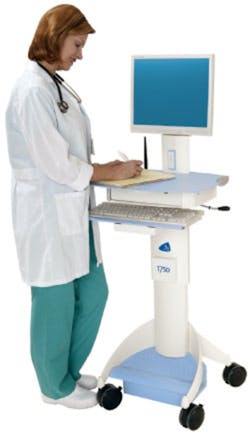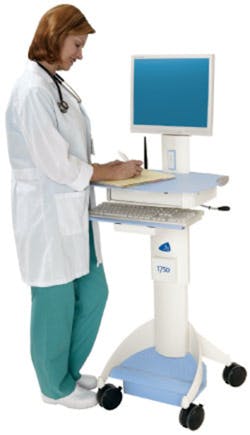Focusing on the needs of nurses can help hospital IT departments make the best technology decisions and improve care giving at the bedside.
Connecting with patients always has been a key objective of our leaders at All Children’s Hospital (ACH). Since ACH was founded in 1926, it has grown into a leading pediatric referral center that is dedicated to advancing treatment, education, research and advocacy in child health. Our 216-bed teaching hospital is affiliated with the University of South Florida College of Medicine, where more than 140 pediatric specialists provide state-of-the-art medical and surgical care for children. These specialists work closely with nurses, therapists, pharmacists and other caring professionals who understand the medical, social and emotional needs of each stage of childhood and adolescence.
Focusing on the needs of nurses can help hospital IT departments make the best technology decisions and improve care giving at the bedside.
Through the years, our professionals have gained this strong understanding of children by spending as much time as possible at their bedsides. In order to help nurses and other clinicians spend even more time with our patients, we have invested in software applications that allow caregivers to chart next to a patient’s bed, versus leaving the room to go to a centralized nurses’ station. To facilitate the charting process, we wanted to run these applications on workstations that nurses could easily take directly to the bedside for charting and rounding.
The Trouble With COWs
Four years ago, we implemented computers on wheels (COWs) with the goal of encouraging our nurses to chart at the bedside. The problem was, our nurses didn’t readily adopt the devices. At first, they were enthusiastic about the new technology, but as time went on, the problems became evident. The biggest complaints about the carts we were using came from our aging workforce and were centered on ergonomics, such as small screen size and a difficulty pushing the heavy contraptions. Our nurses also expressed frustration with the carts’ large size and cumbersome design, which prevented them from easily navigating tight spaces in patient rooms. And, because nurses never really knew how much battery life remained in a COW, they would forget to charge them after their shifts. When other nurses arrived to begin the next shift, they were hard pressed to find one with a full battery.
After several months, the carts sat abandoned in an area that soon became known as the “COW corral.” It wasn’t simply an issue with a change in culture — the staff really tried to adopt the new technology, but with little success.
We learned that happy nurses make our patients happy. Once we addressed our nurses’ concerns, they enthusiastically adopted the new technology. As a result, they spend more time caring for patients and less time worrying about technology.
We considered tablet PCs, but our nurses did not like their small screen size. The general consensus was that tablets might be fine down the road for applications, such as bar coding, but our clinicians preferred a large monitor for daily general use.
So, it was back to carts. We had already gone through the cart selection process once before, and it was easier to choose a workstation the second time around. Simply put, we knew what we didn’t want. We didn’t want anything heavy, cumbersome, difficult to navigate or uncomfortable to use. And, we didn’t want to have to guess how much battery life remained.
Our IT department collaborated with our nursing staff to assess the current COWs and to determine what changes needed to be made.
For more information on
Flo mobile clinical workstations
Overwhelmingly, our nurses asked for a workstation with a smaller footprint, a height-adjustable work surface, the ability to add or upgrade components as needed, and the ability to provide on-screen battery-charge status. The smaller footprint was necessary to navigate in and out of patient rooms, as well as for easier storage between shifts. The height-adjustable work surface was requested after numerous complaints from nurses about feeling uncomfortable when using our previous COWs. The nurses wanted a workstation that could be customized for various departments, depending on their needs. For example, nurses in the ICU might require a chart rack, while Med Surg might not. Finally, our clinicians communicated that any method that could alert them when the cart’s battery was getting low would be a huge plus.
Our project leaders brought in carts from four different vendors so that our clinicians could conduct a side-by-side comparison over a several-day period. We placed surveys for user feedback in the area, and we took all opinions into consideration. The nurses eliminated a couple of models right off the bat because they were too hard to push. The two remaining models were tested in the nurses’ workflow for a few more days. Overall, the nurses and the IT department preferred the Flo 1750 mobile clinical workstation.
We considered tablet PCs, but our nurses did not like their small screen size. The general consensus was that tablets might be fine down the road for applications, such as bar coding, but our clinicians preferred a large monitor for daily general use.
Our nurses chose it for its height-adjustable work surface, footrest and large monitor. The small footprint also facilitates bringing the workstation directly to the point of care. However, the feature that elevated it to number one on the list was the battery meter. This feature displays the battery data on the workstation monitor so users can see what percentage of the battery is left. Our IT leaders preferred the 1750 because it was modular and easily customized, meaning we would not be required to replace the entire workstation if all we wanted was a different accessory or a simple computer upgrade. Flexibility is paramount in a hospital such as ours, where each department requires a different design. Since August 2007, we’ve deployed nearly 70 new mobile workstations in our emergency center, neonatal intensive care unit, pediatric intensive care unit and preoperative areas to rave reviews from our nursing staff and IT department. The carts feature Wyse thin clients and 20-inch monitors.
From COWs to WOWs
The biggest testament to our success is the fact that our nurses are actually using the new mobile workstations, instead of abandoning them in the old COW corral. Now, everyone wants a “WOW” (workstation on wheels) including the physicians, who take them on their rounds. When the IT department has to borrow a workstation, the nurses complain because they want to use them throughout their shift. This is an enormous change from the days when nurses barely noticed if a cart was missing, or they were actually happy to see the cart wheeled out the door and into the IT department.
We’ve been amazed at how a simple technology change can impact our workload for the better. We no longer receive phone calls about dead batteries, because they always know how much power is left. Moreover, the workstations’ wireless signals and computers work flawlessly. The need for nurses to continuously sign on because the battery died, or they dropped a wireless signal, has been virtually eliminated. In the past, we had to reboot repeatedly, which was time consuming and aggravating for our nurses. Now, if we ever do have to reboot, our system automatically logs the user back in, which is a win-win for our nurses, as well as our IT department. And, the thin client technology is much faster, which thrills our clinicians to no end.
We hope to purchase more mobile workstations for our cardio intensive care and Med Surg units. Each workstation will have additional packages based on departmental needs. We’ve already added chart holders and tilting keyboards, and are evaluating baskets and hand-sanitizer holders.
We learned that happy nurses make our patients happy. Once we addressed our nurses’ concerns, they enthusiastically adopted the new technology. As a result, they spend more time caring for patients and less time worrying about technology.





